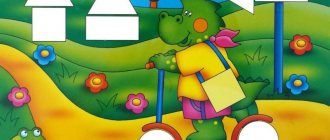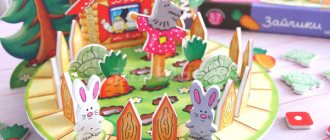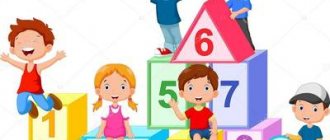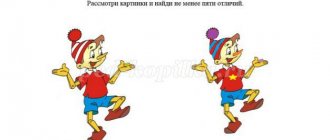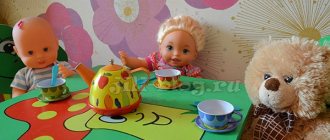Progress of the game.
The teacher brings toys - a bear and a fox and places them on chairs on opposite sides of the flannelograph. He says that animals love gifts very much. Invites children to choose gifts for animals. The teacher lays out the favorite objects of the bear and fox on the flannelgraph one by one.
The bear loves honey in a blue pot and condensed milk in a yellow jug. The fox loves chicken in a blue pan and milk in a yellow bag. Children receive cards and when the teacher asks: “Who has the same subject?”
- show
cards and name the object . Gifts vary in size: large for a bear, smaller for a fox.
Children must take into account not only the color, but also the size of the item they are looking for. Having determined who gets what gift, the children tell why the bear likes this particular thing and what he will do with this gift. If the child identifies the objects correctly, then the heroes rejoice and the children clap their hands. If it’s wrong, the heroes turn away. Card No. 4 D/game “Who rides what?”
(
pozn .) Program content. Teach children to group vehicles . Choose transport for the animals. Choose a vehicle so that the animals want to ride on it (in accordance with the professions of the animals)
.
Equipment. Identical sets of pictures for flannelgraph and individual sets of cards : with types of transport (taxi, ambulance, emergency service, “Bread”
) and with images of animals in clothes corresponding to their profession (a fox - in a white cap and a baker's apron; a wolf - in a white coat and a doctor's cap with a pipe in its paws; a hare - in a taxi driver's uniform cap; a bear - in an emergency service suit with a set of tools ).
Progress of the game
Objects of labor of representatives of different professions (toys)
: a set of medical instruments, a set of kitchen utensils, a hairdressing set, household appliances, etc. The teacher invites one child at a time to the table, he takes a toy and names it. The rest name who needs this item for work.
Option: find all the tools for a certain profession and name them
Card No. 24 D/game “Find the same”
(
pozn .) Program content: teach children to compare objects, find signs of similarities and differences in them, cultivate observation, ingenuity, and coherent speech.
Game rules: whoever finds the same toys speaks about it in the teacher’s ear, you cannot name them, everyone must find them.
Progress of the game
There is tea, dining and kitchen utensils on the table. Cook Katya is sitting at the table. Teacher: “Children, Katya needs to be fed lunch. There are different dishes here. We will put on the table in front of Katya only what is needed for lunch.” One by one, the children find the items they need. The teacher asks what it is and why.
At the request of the teacher, the children find all the objects: plates, forks, meadows, bread bins, name them correctly and arrange them beautifully on the table, not forgetting to lay out the tablecloth and place the napkin holder. They wish Katya bon appetit and clear the dishes after dinner.
Card No. 16 D/game “More or less”
"
(
pozn .) Program content: to train children in distinguishing and comparing objects, to cultivate attention and speed of reaction.
Game rules: according to the teacher, arrange objects in descending order and vice versa, the winner receives a chip.
Progress of the game
The teacher collects tree leaves on a walk with the children (according to the number of children)
and keeps them with him
(one leaf from each tree)
.
Conversation: “Children, do you know what trees grow on our site? Let's name them and approach them (they name them, look at trees and leaves)
. By comparing and naming leaves, the teacher finds out what children know about trees and how the leaves of different trees differ.
“Now we’ll play. I have leaves from different trees in my hands. I'll give you a piece of paper. When I show a leaf and say, “Whoever has the same leaf, fly to me!”
, you will run to me. Be careful.” Steps aside and gives a signal.
The teacher makes sure that the children run after the signal. Complication: run to the tree from which the leaf comes.
Card No. 19 D/game “Wonderful bag”
(
pozn .) Program content: teach children to recognize objects by touch, cultivate endurance, speech.
Game rules: guess a familiar object by touch, take out the object, and then talk about it.
Progress of the game
Before the game, the teacher ties a ribbon on each child’s hand. The colors are different, but repeated so that children can find the same ribbons and pair up. Find out what color the ribbons are and who has the same ribbons. “Now we’ll play. You will run around the room, and when I say “Find your match!”
, you will look for someone who has the same ribbon. Everyone ran around the room!”
The teacher sings a song or claps his hands, gives a signal, and the children look for a mate. The teacher asks to check whether the children identified the color correctly.
You can find identical shapes of the same color.
Card No. 23 D\game “What to whom?”
(
pozn .) Program content: teach how to relate tools to a profession, cultivate an interest in the work of adults, a desire to help them, and try on the role of representatives of different professions.
Game rules: name the profession in accordance with the tool. Remember where you saw such an employee.
